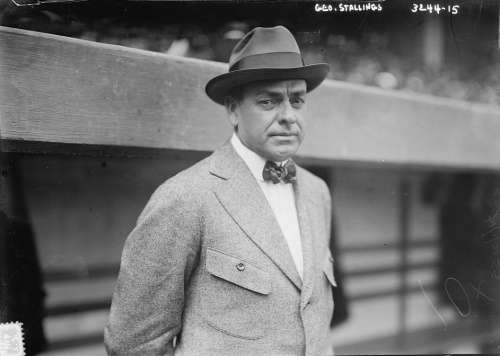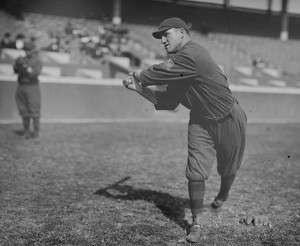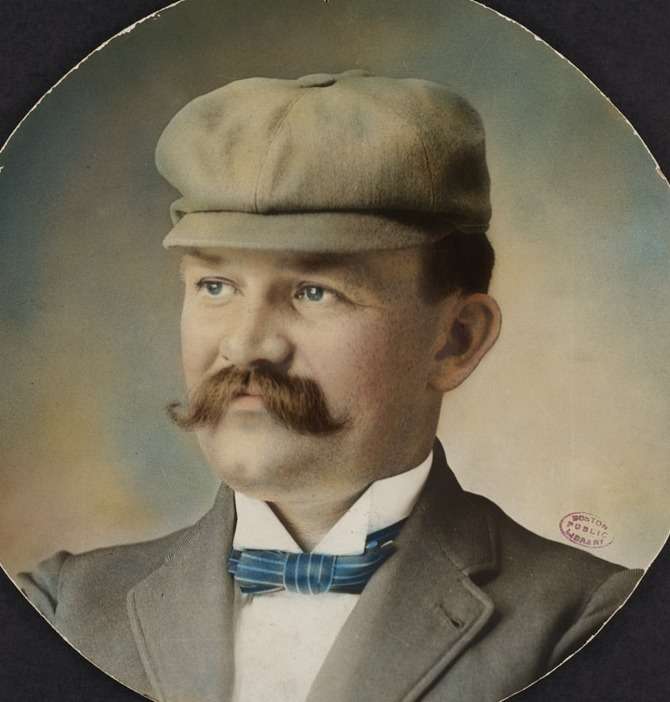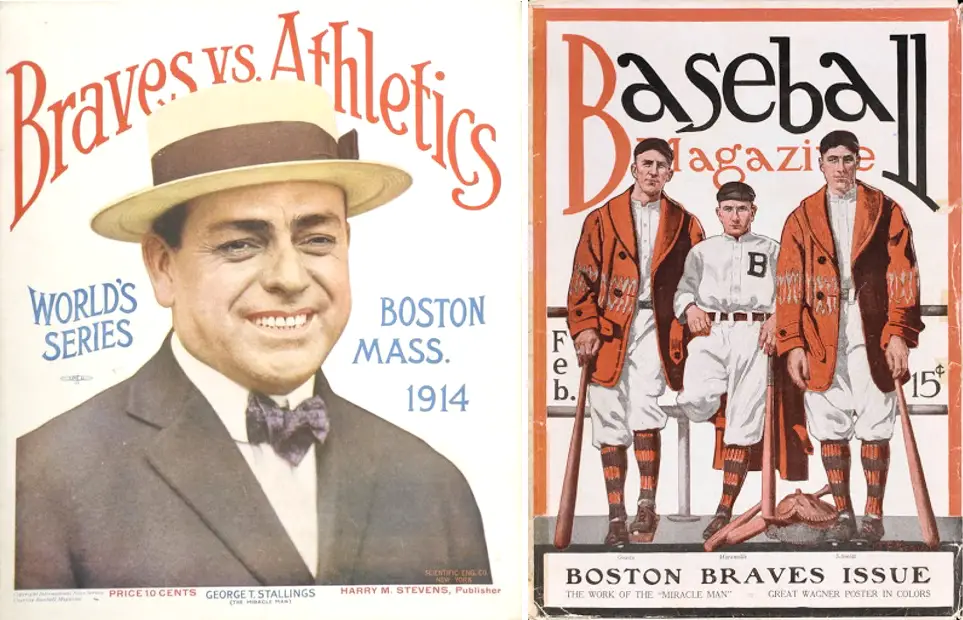On July 18, 1914, the Boston Braves were in last place as usual. But that season the madmen from Boston made the most stunning comeback in baseball history after a humiliating 10-2 loss to a Buffalo farm team.
The team went from last place to first in two months and then swept the heavily favored Philadelphia Athletics in the World Series. Their last-to-first rally still stands as one of the greatest reversals in baseball history.
The 1914 Braves
The Braves had languished in the cellar for a decade, averaging 100 losses a year. They played in a rickety little ballpark that seated 5,800, not that they needed that many seats. The team was sold in 1912 to former pitcher John Montgomery Ward, and John Gaffney, a Tammany Hall alderman. Until then they’d been known as the “Beaneaters,” the “Doves” or the “Rustlers,” but Gaffney named them the Braves after the New York political machine’s symbol, Chief Tammanend.

George Stallings. in 1914. Courtesy Library of Congress.
The new owners hired George Stallings, a crusty, some said sadistic, plantation owner from Georgia. Stallings could fly into a schizophrenic rage over a dropped fly ball. Even by baseball standards Stallings was extremely superstitious. He hated yellow signs and yellow clothing. Yellow ballpark advertisements had to be painted over before he’d let the team play. He would freeze in position when his team started a rally. Once, the Braves rallied as he picked up a pebble in the dugout. When the rally ended he had to be helped off the field.
But he knew baseball.
In 1913, Stallings’ first season, he managed the hapless Braves to only 82 losses and 69 wins. By the start of 1914, though, Stallings had begun to assemble his unlikely champions. He later described the team as having “one .300 hitter, the worst outfield that ever flirted with sudden death, three pitchers and a good working combination around second base.”
They also had game, and they would do anything to win. Once, shortstop Rabbit Maranville let himself get hit in the head by a fastball so he could walk in the winning run. In that tough, raw era of the game, Stallings’ 1914 Braves were the toughest, rawest team in baseball.
“Don’t end up in jail”
Stallings told his players “Do what you want but don’t end up in jail and come to play every day.” They did exactly what they wanted. Maranville once dove into a hotel fountain after a few cocktails and emerged with a goldfish between his teeth.

Rabbit Maranville famously swam with the fishes in a hotel fountain. (Courtesy Boston Public Library)
Stallings’ most astute move was to buy the contract of Chicago Cubs player-manager and Hall of Famer Johnny Evers before the 1914 season. Evers, the best second baseman in the National League, had an almost psychic ability to position himself right where the ball would be hit. Stallings also chucked a few veterans. Five rookies on the 26-man roster hadn’t played a day in the majors.
The Braves lost their Opening Day game to Brooklyn, then went on to lose some more. Pitchers were wild, or their arms were sore. Maranville came down with tonsillitis, Evers got sick. They lost game after game by one run. They seemed stuck in the cellar, 15-1/2 games behind the first place New York Giants.
Then they lost in Buffalo to what Evers described as “a soap company team.” What happened next isn’t clear. Stallings may have chewed them out. Evers may have inspired them. Stallings may have told them to go out and tie one on. Whatever it was, it worked.
Suddenly, They Got Hot
They won 12 of the next 16 games on the road and rocketed to fourth place. In mid-season. During the streak, Stallings traded for new players.

1914 Braves left fielder, Joey Connolly, the pride of North Smithfield, R.I. Photo courtesy the Library of Congress.
The light-hitting team started to get hits when they needed them and coming from behind to win. Joey Connolly, the 5’7” left fielder from Rhode Island, started to hit, ending the season with a .306 average. Maranville hit a clutch homerun in one game; the Springfield, Mass., native admitted he was so hungover he didn’t see the ball.
They scrapped for every win. The players researched the opposing teams to come up with the best insults. Evers argued with umpires, Maranville mimicked them. More importantly, they transformed the infield into a hitters’ Death Valley.
With first baseman Charlie “Butcher Boy” Schmidt, they turned more double plays than the famed Cubs’ Tinkers-to-Evers-to-Chance infield.
The pitching solidified. From July 9, sophomore pitcher Bill James went 19-1 with a microscopic 1.51 ERA. The only game he lost was 3-2 to the Pirates in 12 innings. Pitcher Dick Rudolph, a clever curveball-spitball pitcher, went 26-10 that season. He had talked his way onto the team after a chance encounter with the third base coach. Lefty Tyler, a native of Derry, N.H., with a peculiar motion, rounded out the big three pitchers with a 16-13 record. Even George Davis, rarely used as a starter, pitched the National League’s only no-hitter that year in September against the Phillies.
Laying Waste to the League
As the team caught fire, Boston got caught up in the excitement. Their ballpark, the South End Grounds, could only hold 5,800 fans. The Red Sox offered them the use of Fenway Park. On their first home game at Fenway the attendance was 20,000. Among the fans were tavern keeper Michael T. “Nuf Ced” McGreevey’s small army of sports fanatics, the Royal Rooters, who happily transferred their loyalty from the Red Sox. (Nuf Ced got his nickname by pounding his fist on the bar and exclaiming “Nuff Said” when he’d won a sports argument.)

Michael “Nuf Ced” McGreevey
From July 19 to the end of the season, the Braves lay waste to the rest of the National League, winning an incredible 51 of 67 games. On Sept. 29, they clinched the National League pennant.
The team was expected to lose the World Series to the dominant Philadelphia Athletics, who had a Hall of Fame pitching staff and a $100,000 infield. The A’s ace, Chief Bender, called the Braves “bush league.”
The Royal Rooters
The Royal Rooters followed the team to Philadelphia for the first two games. Boston Mayor John “Honey Fitz” Fitzgerald, his daughter Rose and her new husband Joe Kennedy went along. The Braves took the first game, shocking the Athletics with a 7-1 victory. They won the second game, too, 1-0.
Back in Boston, the Royal Rooters paraded to the field in Indian dress. They sang their fight song “Tessie” throughout Game 3, unnerving the A’s pitchers. Braves catcher Hank Gowdy won the game with a 12th inning walk-off homerun, the only dinger of the series. (Gowdy, by the way, was the only Major League Baseball player to fight in both World War I and World War II.)

The Braves 3-1 victory over the A’s in the fourth and final game of the series inspired the wildest celebration ever. Fans swarmed the dugout, demanding Stallings give a speech on top of it. Maranville was dragged from the shower, and half-dressed he too gave a speech on top of the dugout. The Rooters’ band played “Tessie,” 5,000 fans marched around the park through the Fens and down Huntington Ave. where they serenaded the A’s at the Copley Plaza.
The losing manager, Connie Mack, was gracious in defeat. “A great team,” he said. “One of the greatest. It had great spirit and just wouldn’t be beaten.”
With thanks to The Boston Braves, 1871-1963, by Harold Kaese. Find out more about the Braves at the Boston Braves Historical Association. This story was updated in 2022.


13 comments
Tough bunch!
[…] lived two blocks from Hall of Famer Rabbit Maranville, the Boston Braves shortstop who gave him a glove and tips on how to play the […]
[…] He was born on a farm in 1871 in North Brookfield. He played for the Boston Beaneaters (later the Braves) from 1896 to 1899, growing increasingly erratic. He would disappear for days. He suddenly slapped […]
[…] to legend, the Protestant owners of the Boston Red Stockings (later the Braves) asked him to change his name to ‘Rourke.’ He […]
[…] at the back of the train that remained on the tracks. They were on their way to Boston to play the Braves. Hall of Fame catcher-manager Roger Bresnahan directed the team’s rescue efforts, credited with […]
[…] players who had bit parts in his previous plays: Cap Anson of the Chicago White Stockings and Boston Beaneaters star Mike King Kelly, the model for Casey at the Bat. The ballplayers were lousy actors and the […]
[…] Louis Sockalexis made his major league debut nearly 20 years earlier. Perhaps they were thinking of Boston’s miracle Braves, who won the World Series the year before. At any rate, the Indians adopted the image of Chief […]
[…] In 1909, his fortunes took a turn for the worse. His real estate debts caught up with him, and to make up for his deficits he sued his wife. Laura Patterson Small had carried on an affair with Arthur Soden, president of the Boston Braves. […]
[…] owning the team by himself. The team was first called the Braves because it shared a stadium with Boston’s National League baseball team. The next year the team moved to Fenway Park and Marshall changed the name to the Redskins after […]
[…] may also enjoy this story about the 1914 Miracle Team, the Boston Braves, here. This story about Nuf Ced McGreevey was updated in […]
[…] Stadium struggled for years, intermittently attracting farm teams for the Boston Braves, the Cleveland Indians and the Boston Red Sox. In 1977, a Canadian businessman named Ben Mondor […]
[…] 1896 to 1899, he played for the Boston Beaneaters (later the Braves), growing increasingly erratic. Sometimes he would disappear for days. Once he suddenly slapped a […]
[…] of the league. Their opponents, the improbable winners of the National League, the Boston Braves who were in last place on the Fourth of July before going on one of the more amazing hot streaks in baseball history to win the National League […]
Comments are closed.